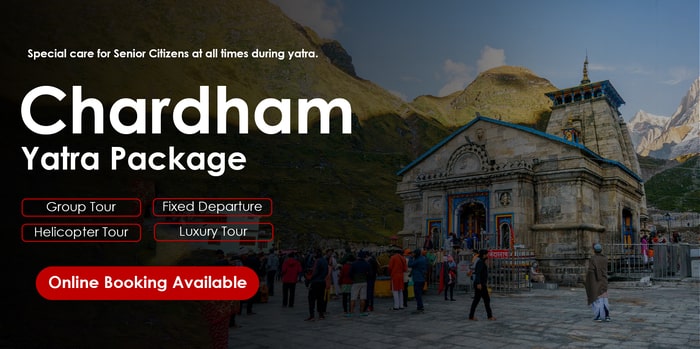Last Updated on January 17, 2025
Lord Shiva, the destroyer, is worshipped not only in India but abroad as well. Lovingly named ‘Bholenath’, he plays a focal role in forming the foundation of belief and religion in the culture of India. The entire land of India is dotted with innumerable big and small temples dedicated to Lord Shiva, and these remain thronged by Shaivites and believers no matter what the season is.
If you are planning on indulging in a spiritual experience, then given below are some of the most popular and highly revered temples dedicated to Lord Shiva that should definitely be on your bucket list:
Kedarnath Temple (Uttarakhand)

Kedarnath Dham is a stunning representation of the ancient religion of India, which still persists to the present day. Established by the great 8th-century sage and philosopher Adi Shankaracharya, the history of Kedarnath dates back to the time when the Pandavas were on their journey to heaven and had created the temple to honor the glories of Lord Shiva. The temple is a mark of deep-rooted spirituality in India and is visited by thousands of devotees each year when it opens its doors for public Darshan during the holy eve of Akshay Tritiya in May.
Best Time to Visit – May to June and September to November
Arunachaleshwara Temple (Tamil Nadu)

The first thing that comes to mind when you think of this pristine temple is the sheer staggering height and its opulent architectural wonder. People can witness the opulent and highly detailed work of South Indian craftsmanship on every inch of the temple walls. Lord Shiva is worshipped as Agni Lingam here, and the four towering Gopurams represent the four directions of the temple. This massive temple complex is located on the lap of Arunachal Hill. If you want to truly experience the grandeur and spirituality, then visiting during the time of festivals would be a good idea.
Best Time to Visit – December to February
Somnath Temple (Gujarat)

This temple has to be one of the most majestic temples dedicated to Lord Shiva, and its spirituality lies in the fact that it is believed to be the first Jyotirlinga in India, along with finding its mention in various Hindu holy texts, such as the Shrimad Bhagavad Gita, Shiv Puran, and Rig Veda. The imposing structure of the temple stands tall on the banks of the Triveni Maha Sangam. Visitors get washed over by a deep sense of history that this place holds. The place is also known for its entertainment options, which include a thrilling light and sound show.
Best Time to Visit – October to March
Kashi Vishwanath (Uttar Pradesh)

This temple is one of the most prominent and significant shrines for Lord Shiva and has always been a focal point for Hindu pilgrimage since time immemorial. Built in true Hindu architectural form, the Kashi Vishwanath temple of Varanasi is the oldest temple in one of the oldest living cities of India. The temple has a long history of battling invaders and looters who constantly robbed the temple of its riches and demolished it. However, the current temple stands tall in all its might and was built by the Maratha ruler Ahilya Bai Holkar of Indore in 1780.
Best Time to Visit – November to April
Baidyanath Temple (Jharkhand)

This glistening white structure, dedicated to the physician form of Lord Shiva, is one of the most significant Jyotirlingas in India. The history of this temple can be traced back to the era of the Ramayana, and this place is believed to be the location where Ravana (an avid Lord Shiva worshipper) performed his penance to the Lord and sacrificed his 10 heads there. Lord Shiva appeared to him in the form of a doctor and took care of him. The temple is known for being a place where intense Tantra rituals take place along with post-funeral rites.
Best Time to Visit – September to April
Pashupatinath Temple (Madhya Pradesh)

Seated majestically amidst the bustle of Mandsaur is the only Pashupatinath temple in India. Located on the banks of the river Shivna, this shrine of Lord Shiva as the ‘Lord of the Animals’ has to be one of the most enigmatic temples. The rich history of this temple can be traced back to the 1st millennium CE, thanks to its rare Lord Shiva iconography. One of the most striking features of this temple is the presence of the unique and one-of-a-kind idol of the eight-faced presiding deity, marking sculptural brilliance.
Best Time to Visit – September to March
Lingaraja Temple (Odisha)

Known for being one of the tallest standing temples in Odisha, this temple represents the classical and typical Kalinga style of architecture, whose creation can be dated to as early as 1,000 AD. Every wall inside and outside the temple is adorned with fine carvings and detailed engravings, which every visitor is bound to admire. Just like other Lord Shiva temples, visitors have the option of attending the sound and light show that takes place here. Situated in the heart of the city, the temple, along with its 108 other temples inside its premises, seems to radiate deep spirituality to the surrounding city.
Best Time to Visit – December to February
Kailasa Temple (Maharashtra)

Located among the largest monolithic rock-cut group of caves in Ellora and pegged as cave number 16, this temple is one of the most wonderful marks of human engineering and expert craftsmanship that cannot be found in the present day and age. This temple is named so since the creator of this temple, King Krishna I, wanted to name it after the Himalayan home of Lord Shiva, i.e., Mt. Kailash. Inside the temple, one can witness numerous intricately carved panels that finely depict the adventures of the Mahabharata and Ramayana. Every inch here is a true testament to the height of creativity in India during that time.
Best Time to Visit – November to March
Sivasagar Sivadol Temple (Assam)

Located near the ‘ocean of Lord Shiva’ or Sivasagar, this temple or Dol (in Assamese) is located within the heart of the city of Assam. This is one of the recently developed temples, built from 1313 to 1738. It not only consists of a Lord Shiva shrine but also has shrines for Lord Vishnu and Goddess Durga. The temple serves as one of the prime crowd-pullers for religious tourists, and it witnesses a huge turnout during the on-season. The temple walls inside are covered with images and carvings of several gods and goddesses, which adds to the overall spirituality of this place.
Best Time to Visit – Throughout the year
Natraj Temple (Tamil Nadu)

Built in the 10th century and standing tall in the district of Chidambaram, this is one of the most awe-inspiring temples of India. As the name suggests, this temple is dedicated to the dance form of Lord Shiva, and it is truly a sight to behold. You will witness some of the most intricately drawn carvings of 108 karanas from the famous Natya Shastra. The towering Gopuram is believed to represent the wonderful blend of art, creativity, and spirituality, which can be clearly seen from the moment you set foot here.
Best Time to Visit – November to March
Baijnath Temple (Himachal Pradesh)

This ancient temple, dedicated to the physician form of Lord Shiva, is located amidst the untouched beauty of the Himalayas in the district of Kangra. This rock temple is a masterpiece of Indian architecture and sits majestically on the banks of the holy river Beas. The temple can also be visited for its stunning surrounding beauty of lush green rolling hills and wide-open blue skies. This temple complex has been continuously preserved by ASI for its incredible architecture and finely detailed engravings.
Best Time to Visit – April to September
Tungnath Temple (Uttarakhand)
Believed to be 5,000 years old and famed for being the highest Lord Shiva temple in the world, Tungnath temple is ancient temple lies en route the summit of Chandrashila. This Panch Kedar site gives some of the most stunning views of the surrounding greenery and Himalayan beauty. The history of this temple has been traced back to the time of the Pandavas, and its architectural style and design closely resemble the structure of the Kedarnath Dham shrine. It can be visited after covering a steep trekking journey from Chopta, but this journey is worth it.
Best Time to Visit – April to November
Sri Kalahasteeswara Temple (Andhra Pradesh)

Located on a hillside and built during the 11th century by the Chola rulers, this temple literally translates into spider, snake, and elephant, which once worshipped the Shiv Linga located here. This temple is primarily known for offering puja rituals related to Rahu and Ketu. The temple occupies a massive area and exudes incredible devotion to the Lord, making a visit there extremely divine. There are numerous legends related to it, which maintain the glory of this temple. The deity in this Pancha Bhoota Sthalam is worshipped in the form of Vayu (air) Linga.
Best Time to Visit – October to April
Kandariya Mahadev Temple (Madhya Pradesh)

A UNESCO World Heritage site, the name of this temple literally translates into ‘the great god of the cave’. This temple is one of the most iconic and ornate Hindu temples in India and is remarkably preserved. Dating back to the medieval era, this temple complex is part of the Khajuraho group of monuments. The temple has various impressive features, one of which is a finely carved epigraphic inscription. This temple is a blissful experience for history lovers, peace seekers, and spirituality enthusiasts.
Best Time to Visit – October to March
Bhavnath Mahadev Temple (Gujarat)

Perched at the foot of Mt. Girnar and known for being an important Jyotirlinga, this temple should definitely be visited not only because of its religious significance but also to witness the grandeur it displays. The entryway of the temple consists of a large structure depicting a Shiv Linga, completely golden in color, which exudes spirituality. The beautiful surroundings of the undulating mountains and the profound history this place holds makes it a must-visit during your trip to Gujarat.
Best Time to Visit – October to April
Vadakkunnathan Temple (Kerala)

This ancient temple is known for being carved completely out of wood and has utilized the Kerala style of architecture. It may also soon be declared a UNESCO site. The walls, pillars, and every inch of this quaint temple are covered in incredible murals and paintings. A unique feature about this temple is the Lingam; it cannot be seen apart from the crescent on top of it, as it is covered entirely under a huge mound of ghee, which is said to date back to ancient ages and, to this day, does not smell or spoil.
Best Time to Visit – September to April
Tarakeshwar Temple (West Bengal)

Dating back to the 18th century, this temple is one of the oldest standing temples in the city, with the presiding deity here being “Lord Tarakeshwar.” It is made in a typical Bangla architectural style, and the current structure is said to have been constructed by Raja Bharamalla. The Shiv Ling here is completely covered inside a metal frame to protect it from destruction, and there are small openings through which pilgrims can touch the Lingam.
Best Time to Visit – October to March
Kotilingeshwara Temple (Karnataka)

Popular for being the largest Shiv Linga temple in the world, this holy shrine of Lord Shiva is one of the prime attractions of Karnataka. The name ‘Koti’ can literally be translated to ‘crore’, which represents the amount of money that went into making this temple. The massively towering Linga stands at an astounding height of 108 feet and is surrounded by lakhs of small Lingas. The premises here also include a structure of Nandi, the bull, installed on a platform, which is 60 feet in length. You will truly experience the positive and spiritual vibes of Lord Shiva here.
Best Time to Visit – October – March
Brihadeeswara Temple (Tamil Nadu)

Located in the district of Thanjavur and dating back to as early as 1010 AD, this uniquely built temple represents one of the most astounding architectural wonders in India. Every inch of every part is covered in detailed representations of South Indian architecture, which has earned it a place as a UNESCO World Heritage site. The temple is a wonderfully imposing structure and built entirely out of granite, which adds to its beauty and magnificence. You will also be able to pay your respects to Parvati, Kartikeya, Ganesha, Varahi, and others.
Best time to visit – November – March
Shore Temple (Tamil Nadu)

This UNESCO World Heritage site is one of the most magnificent architectural wonders of India and sits peacefully on the shores of the Bay of Bengal. This complex of shrines offers one of the most peaceful and spiritual experiences. The construction of this temple was initiated by King Narasimhavarman II during the mid-7th century, which began with the creation of cave temples and monolithic Raths. This temple is also famed for being one of the oldest rock-cut stone temples in South India and should definitely be visited at least once in your lifetime.
Best Time to Visit – October to May






















 Call
Call WhatsApp
WhatsApp Enquiry
Enquiry